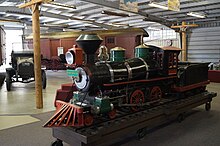Park Railway at Silver Lake
| Park Railway at Silver Lake | |||||||||||||||||
|---|---|---|---|---|---|---|---|---|---|---|---|---|---|---|---|---|---|
|
Armitage-Herschell Park Railway around 1902
| |||||||||||||||||
| Gauge : | 381 mm ( Liliputbahn ) | ||||||||||||||||
|
|||||||||||||||||
The Silver Lake Park Railroad was a 15- inch (381 mm) gauge miniature railway in Silver Lake , Ohio, opened in 1902 by the Lodge family .
history
The park railway was pulled by a scaled-down steam locomotive , but the open passenger carriages had no prototype. The midget locomotive was built around 1901 by the Armitage-Herschell Company in North Tonawanda , Niagara County , New York , as park railways became increasingly popular. The locomotives of this manufacturer could pull up to ten passenger cars with seats for 40 children or 20 adults.
The steam locomotive, its tender, and three passenger cars were purchased for $ 1,050 for the locomotive and $ 75 for each car, which is $ 1.00 a pound since the locomotive weighed 1,050 pounds. The Ohio Steel Company in Cuyahoga Falls manufactured miniature rails with the unusually large weight of 8 kg / m for park railways as well as switches and their frogs for 42 $ / t.
The loop-shaped railway line began south of the large pavilion that had been built in 1898. The station was on the lakeshore near the ship landing stage. The route led along the lakeshore, past an old log cabin next to the future aquarium. She then passed the shooting gallery, the stone-built ice warehouse that was later converted into a cage for the pumas , as well as cages for monkeys, a wolf, raccoons, a badger and foxes. From here you could also see the aviaries for eagles, falcons and owls and the bear pits. After the menagerie , it ran along the lake again, past the Linewood log cabin to another section of the lake. This original route allowed passengers a view of the lake and the zoo animals, which quickly made the menagerie famous.
The miniature railway with this original route was not as profitable as it should have been because it was too far away. In the following year, a new route with an extensive detour was created. This doubled the travel time and the train journey became very popular. Over the years the route has been changed several times.
The locomotive had to be constantly repaired as early as the second summer. The steamship's engineer, Frank Jones, was invaluable in making repeated repairs to the locomotive and its parts. Nevertheless, the locomotive was no longer used and offered for sale.
The diminutive Sammy Wise from Loudonville , Ohio, was employed as the first conductor on the park railroad. He was only 1.22 m tall at the age of 28 when he came to Silver Lake. He was well-proportioned and self-important and very popular with campers and colleagues. In his uniform with a shiny lantern on his left arm and his ticket punch in his right hand, he was an attractive little conductor. He worked with the Park Railway for several summers, until his death in the winter of 1906–1907.

George Lodge was enthusiastic about the train, for which he, Frank Jones and Sammy Wise had built a new boiler locomotive for months in 1903 for the Biggs Boiler Works Company in Akron. In 1904 he built a more powerful locomotive, later called the Little General , which is still on display in the Travel Town Museum today. After Frank Jones passed away, he built another even larger locomotive in his own workshop. He also built five new cars so that two trains with four cars each could run at the same time.
The 1917 summer season was the last the park operated, but the park railroad continued to be popular and in service. The park's retail price did not include the rails, locomotives, and trains. Finding no other buyer, William Lodge bought the rails and rolling stock for $ 1,000 and stored them on his farm. After a few years, he sold the locomotive and wagons to Buckeye Lake Park Co. in Licking County , Ohio. This operated the trains for several summers and then sold them to a parking company near Toledo , where they were still in operation in 1944.
Individual evidence
- ^ Paying Park Attractions. Daily Street Railway Review, Vol. XI, No. 3, October 11, 1901, p. 707.
- ^ A b c d e f g William R. Lodge (manuscript): An Historical Anthology of Silver Lake. ( Memento of the original from June 26, 2017 in the Internet Archive ) Info: The archive link was inserted automatically and has not yet been checked. Please check the original and archive link according to the instructions and then remove this notice. February 1947.
- ^ Daniel V. Markowitz: The "Little General" Miniature Train. ( Memento of the original from August 30, 2017 in the Internet Archive ) Info: The archive link was automatically inserted and not yet checked. Please check the original and archive link according to the instructions and then remove this notice.





